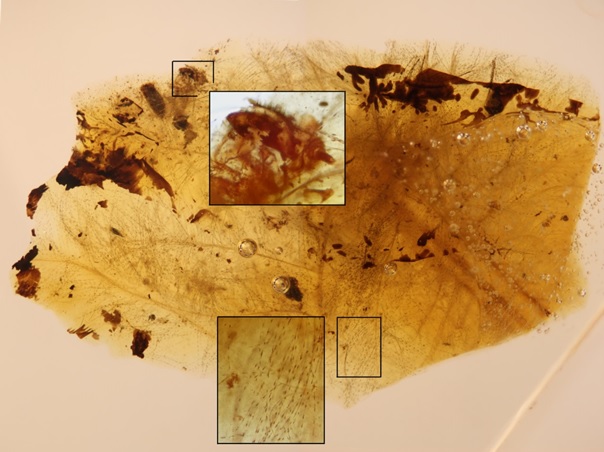Close relationship between insects and feathered dinosaurs
Spanish Cretaceous amber has preserved feathers and beetle larvae that today live by feeding on these in bird nests. The feathers do not belong to a modern bird but to an avian or non-avian dinosaur.
This feeding strategy by beetles with today's birds already occurred about 105 million years ago between beetles and dinosaurs.
The interaction between arthropods and vertebrates is rare in the fossil record, although their coexistence has been known for more than 500 million years. With great probability already in the Silurian, if not earlier, marine arthropods such as trilobites formed part of the diet of the first fish with jaws. Surely their interrelation increased when both arthropods first and then vertebrates conquered the continental environment during the Devonian.
The prestigious scientific journal Proceedings of the National Academy of Sciences of the United States of America (PNAS) publishes that pieces of amber found in the Lower Cretaceous of Spain show that the larvae of some beetles fed on the feathers of theropod dinosaurs about 105 million years, and that they lived inside their nests. In the study, led by Enrique Peñalver and Ricardo Pérez de la Fuente, researchers from the CN-IGME CSIC and the Museum of Natural History of the University of Oxford respectively, researchers from the UB and IRBio Sergio participated Álvarez-Parra and Xavier Delclòs.
One of the amber fragments studied, discovered in the San Just site (Utrillas, Teruel), contains molts of dermestid beetle larvae (skin beetles) among a set of dinosaur feathers. Today these larvae are usually very destructive, since they can develop pests in certain stored human products, to have the habit of feeding on dry organic matter that is very indigestible and rejected by other organisms such as clothes or skin, among others. However, these beetle larvae play an important role in recycling organic matter in the natural environments, and can often be found in bird nests and mammal burrows, where they feed on feathers, hair and skin remains that accumulate there.
In the Cretaceous amber samples with dinosaur feathers that have been studied (modern birds appeared about 30 million years later), dermestid larval molts that do not have stinging structures are associated with them, present in some other groups of the same family, some of them in a state of decomposition and coprolites, presumably of the larvae that would live among the feathers, on which they would feed. For this set of remains of organisms to be found together (feathers, larval molts and coprolites), it was necessary that the resin cast that included them fell on an area where all three types of remains coincided, most likely a dinosaur nest Complete larvae of dermestids, included in the work, have been found isolated from feathers in other pieces of amber from Spain, such as in the amber of Rábago/El Soplao, in Cantabria, which has allowed their characterization.
NOTES
Title: "Symbiosis between Cretaceous dinosaurs and feather-feeding beetles" published openly by the journal Proceedings of the National Academy of Sciences of the United States of America (PNAS).
https://www.pnas.org/doi/10.1073/pnas.2217872120
Authors: Enrique Peñalver, David Peris, Sergio Álvarez-Parra, David A. Grimaldi, Antonio Arillo, Luis Chiappe, Xavier Delclòs, Luis Alcalá, José Luis Sanz, Mónica M. Solórzano-Kraemer and Ricardo Pérez-de la Fuente.
The international and multidisciplinary team is made up of researchers from the Centro Nacional Instituto Geológico y Minero de España (CN IGME-CSIC), the Botanical Institute of Barcelona (CSIC-Barcelona City Council), the University of Barcelona and the Research Institute of Biodiversity (IRBio), the Complutense University of Madrid (UCM), the Parque de las Ciencias de Andalucía, the Autonomous University of Madrid (UAM), and the Real Academia de Ciencias Exactas, Físicas y Naturales (Spain); the American Museum of Natural History in New York and the Museum of Natural History of Los Angeles County (USA); the Senckenberg Research Institute in Frankfurt (Germany); and the Natural History Museum of the University of Oxford (UK).
Funding: Agencia Estal de Investigación (AEI) and the Fondos Europeos de Desarrollo Regional (FEDER) (projects CGL2017-84419 and PGC2018-094034-B-C22 of the Ministry of Science, Innovation and Universities), the Spanish Ministerio de Economía, Industria and Competitiveness (project CGL2014-52163), the Secretariat of Universities of the Government of Catalonia and the European Social Fund (2021FI_B2 00003), and the Ministry of Industry, Tourism, Innovation, Transport and Commerce of the Government of Cantabria, through the public company EL SOPLAO S.L.
In the paleontological excavation and in the management of the specimens of San Just, we have had the help of the Fundación Conjunto Paleontológico de Teruel-Dinópolis and the Diputación General de Patrimonio Cultural de Aragón.
